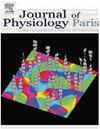The magnetic field of the earth provides many organisms with sufficient information to successfully navigate through their environments. While evidence suggests the widespread use of this sensory modality across many taxa, it remains an understudied sensory modality. We have recently showed that the nematode C. elegans orients to earth-strength magnetic fields using the first pair of described magnetosensory neurons, AFDs. The AFD cells are a pair of ciliated sensory neurons crowned by fifty villi known to be implicated in temperature sensation. We investigated the potential importance of these subcellular structures for the performance of magnetic orientation. We show that ciliary integrity and villi number are essential for magnetic orientation. Mutants with impairments AFD cilia or villi structure failed to orient to magnetic fields. Similarly, C. elegans larvae possessing immature AFD neurons with fewer villi were also unable to orient to magnetic fields. Larvae of every stage however retained the ability to orient to thermal gradients. To our knowledge, this is the first behavioral separation of magnetic and thermal orientation in C. elegans. We conclude that magnetic orientation relies on the function of both cilia and villi in the AFD neurons. The role of villi in multiple sensory transduction pathways involved in the sensory transduction of vectorial stimuli further supports the likely role of the villi of the AFD neurons as the site for magnetic field transduction. The genetic and behavioral tractability of C. elegans make it a promising system for uncovering potentially conserved molecular mechanisms by which animals across taxa detect and orient to magnetic fields.


